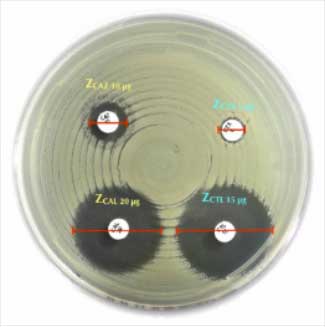Liofilchem® Penicillin G 1+ Clavulanic acid 20 PC Antimicrobial Susceptibility Discs, 20 µg
Catalog No :
CAS Number :
Brand :
In Stock
Specifications:
| Application | Clinical microbiology |
| Storage Temperature | -20°C |
| Product Type | Antibiotic Disc |
| Product Brand | Liofilchem |
| Product Grade | Microbiology grade |
The Liofilchem® Penicillin G 1 + Clavulanic Acid 20 PC Antimicrobial Susceptibility Discs, 20 µg, are specialized discs designed for antimicrobial susceptibility testing (AST) of bacterial isolates. These discs combine Penicillin G with Clavulanic Acid, a β-lactamase inhibitor, to assess the susceptibility of bacteria that may produce β-lactamases, aiding in identifying resistance mechanisms.
Key Features
- Combination Therapy Testing: Contains 1 µg Penicillin G and 20 µg Clavulanic Acid for evaluating the inhibitory effect of β-lactamase on bacterial isolates.
- Diagnostic Value: Useful for detecting resistance mediated by β-lactamase production.
- Standardized: Manufactured in compliance with CLSI (Clinical and Laboratory Standards Institute) and EUCAST (European Committee on Antimicrobial Susceptibility Testing) guidelines.
- Wide Application: Effective in testing both Gram-positive and Gram-negative bacteria, including Staphylococcus aureus, Enterococcus spp., and Escherichia coli.
Technical Specifications
| Parameter | Details |
|---|---|
| Drug Content | Penicillin G 1 µg + Clavulanic Acid 20 µg |
| Disc Diameter | 6 mm |
| Testing Method | Kirby-Bauer Disk Diffusion Method |
| Medium | Mueller-Hinton Agar |
| Control Organisms | Escherichia coli ATCC 25922, Staphylococcus aureus ATCC 29213 |
| Storage Conditions | Long-term: -20°C; Short-term: 2–8°C |
| Shelf Life | 24 months from the date of manufacture |
Regulatory Data
- CE Marked: These discs are CE-certified, signifying compliance with European medical device regulations.
- ISO Certification: Manufactured under ISO 13485 quality management standards for medical devices.
- EUCAST Standards: Validated for use under EUCAST interpretive criteria for AST.
- CLSI Approved: Compatible with CLSI methods for susceptibility testing.
Testing Procedure
- Preparation:
- Use Mueller-Hinton Agar plates prepared according to CLSI/EUCAST standards.
- Adjust the bacterial suspension to 0.5 McFarland turbidity standard.
- Application:
- Plate the inoculum evenly using a sterile swab.
- Place the Liofilchem® Penicillin G 1 + Clavulanic Acid 20 PC disc on the agar surface using sterile forceps.
- Incubation:
- Incubate plates aerobically at 35 ± 2°C for 16–18 hours.
- Interpretation:
- Measure the diameter of the inhibition zone around the disc.
- Compare with EUCAST or CLSI breakpoints to determine susceptibility or resistance.
Interpretation of Results
- A large inhibition zone indicates susceptibility, suggesting the effectiveness of Penicillin G when combined with Clavulanic Acid.
- A small or absent inhibition zone may suggest resistance mechanisms, such as β-lactamase production.
Quality Control Data
| Control Strain | Expected Zone Diameter (mm) |
|---|---|
| Escherichia coli ATCC 25922 | 20–26 mm |
| Staphylococcus aureus ATCC 29213 | 24–30 mm |
Applications
- Clinical Microbiology: Detects resistance mechanisms in Gram-positive and Gram-negative bacteria.
- Pharmaceutical Research: Evaluates β-lactamase inhibitors.
- Hospital Laboratories: Monitors emerging resistance patterns in nosocomial infections.
Comparison with Other Brands
Liofilchem® discs are renowned for their accuracy, reproducibility, and adherence to international standards. Compared to other brands, Liofilchem® discs offer:
- Consistent drug concentration across discs.
- Robust compliance with CLSI and EUCAST criteria.
- Comprehensive quality control data for reliable interpretations.
Storage and Stability
- Store long-term at -20°C and short-term at 2–8°C.
- Protect discs from light and moisture to maintain efficacy.
Conclusion
Liofilchem® Penicillin G 1 + Clavulanic Acid 20 PC Antimicrobial Susceptibility Discs provide a reliable tool for identifying β-lactamase-mediated resistance in clinical isolates. Their compliance with regulatory standards and robust quality control ensure accurate and reproducible results in antimicrobial susceptibility testing.




 0
0
